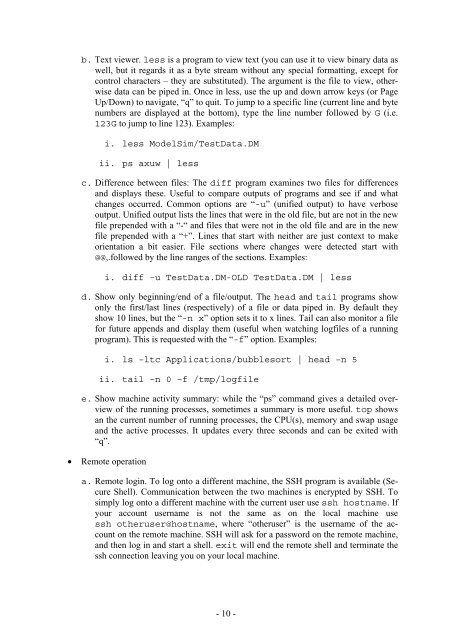Script for Laboratory: Designing embedded ASIPs - CES
Script for Laboratory: Designing embedded ASIPs - CES
Script for Laboratory: Designing embedded ASIPs - CES
Create successful ePaper yourself
Turn your PDF publications into a flip-book with our unique Google optimized e-Paper software.
. Text viewer. less is a program to view text (you can use it to view binary data as<br />
well, but it regards it as a byte stream without any special <strong>for</strong>matting, except <strong>for</strong><br />
control characters – they are substituted). The argument is the file to view, otherwise<br />
data can be piped in. Once in less, use the up and down arrow keys (or Page<br />
Up/Down) to navigate, “q” to quit. To jump to a specific line (current line and byte<br />
numbers are displayed at the bottom), type the line number followed by G (i.e.<br />
123G to jump to line 123). Examples:<br />
i. less ModelSim/TestData.DM<br />
ii. ps axuw | less<br />
c. Difference between files: The diff program examines two files <strong>for</strong> differences<br />
and displays these. Useful to compare outputs of programs and see if and what<br />
changes occurred. Common options are “-u” (unified output) to have verbose<br />
output. Unified output lists the lines that were in the old file, but are not in the new<br />
file prepended with a “-“ and files that were not in the old file and are in the new<br />
file prepended with a “+”. Lines that start with neither are just context to make<br />
orientation a bit easier. File sections where changes were detected start with<br />
@@,.followed by the line ranges of the sections. Examples:<br />
i. diff –u TestData.DM-OLD TestData.DM | less<br />
d. Show only beginning/end of a file/output. The head and tail programs show<br />
only the first/last lines (respectively) of a file or data piped in. By default they<br />
show 10 lines, but the “-n x” option sets it to x lines. Tail can also monitor a file<br />
<strong>for</strong> future appends and display them (useful when watching logfiles of a running<br />
program). This is requested with the “-f” option. Examples:<br />
i. ls –ltc Applications/bubblesort | head –n 5<br />
ii. tail –n 0 –f /tmp/logfile<br />
e. Show machine activity summary: while the “ps” command gives a detailed overview<br />
of the running processes, sometimes a summary is more useful. top shows<br />
an the current number of running processes, the CPU(s), memory and swap usage<br />
and the active processes. It updates every three seconds and can be exited with<br />
“q”.<br />
• Remote operation<br />
a. Remote login. To log onto a different machine, the SSH program is available (Secure<br />
Shell). Communication between the two machines is encrypted by SSH. To<br />
simply log onto a different machine with the current user use ssh hostname. If<br />
your account username is not the same as on the local machine use<br />
ssh otheruser@hostname, where “otheruser” is the username of the account<br />
on the remote machine. SSH will ask <strong>for</strong> a password on the remote machine,<br />
and then log in and start a shell. exit will end the remote shell and terminate the<br />
ssh connection leaving you on your local machine.<br />
- 10 -
















